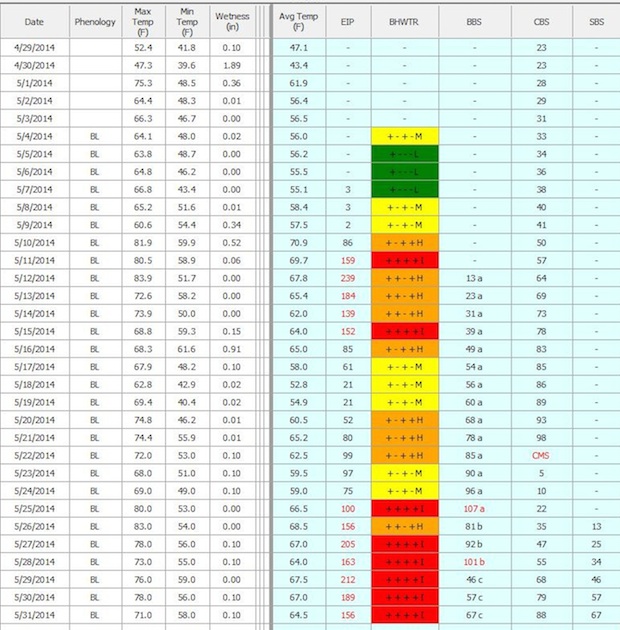7 pm, Thursday, May 22, 2014: Unfortunately, some regions of the Hudson Valley received hail within the last 12 hours. Where fire blight inoculum exists in apple and pear orchards, injuries to bark, leaves, and fruitets may provide entry points for the fire blight bacteria, but that is likely ONLY if trees were already carrying a lot of inoculum. So, if you received hail today, what should you do? This is a tough call, with no clear answers.
Following are five reasons to believe that hail-related risks of fire blight at this point are minimal and/or that there is little that anyone can do to modify those risks at this point:
1. Risks that hail today will trigger fire blight are less than would be the case for hail occurring four weeks later in the season when blossom infections might be producing an abundance of new inoculum if strep sprays were less than 100% effective.
2. Orchards that were sprayed with strep during late bloom (i.e, around May 15) and have no flowers remaining should be OK because they had nothing to support bacterial growth over the past several days (i.e., no open flowers) and they therefore will not have had enough inoculum today to pose a problem.
3. Orchards that were treated with strep plus Apogee earlier during bloom are probably OK without any further action because Apogee will be helping to reduce risks by making the trees more resistant to infection.
4. Trauma blight from hail at this time of year is unlikely if the epiphytic infection potential in the MaryBlyt model is below threshold (i.e., <100) at the time of the hail event. The EIP may actually need to approach 200 before trauma blight becomes really likely, but we just don’t have enough data to make a blanket statement. As shown in the printout from this morning, data for the Hudson Valley Lab (with predicted temperatures entered for today and the next few days) indicate that we were just below the blossom blight threshold with an EIP of 99 today. The marginal EIP suggests low risks from hail.
5. The only known option for reducing fire blight risks following hail is an application of streptomycin within 24 hours of the hail event. However, we lack data indicating how effective strep actually is when applied AFTER hail events. Furthermore, strep sprays should dry or at least remain on the trees for an hour (??) without rain so that the strep can be absorbed. Spraying strep in the rain is not recommended. At the moment, the weather forecasts suggests that it will be difficult to find a window without rain or drizzle over the next 24 hours.
Finally, two warnings:
1. If you know that you have (i) blight-susceptible cultivars (ii) that have a lot of recently opened flowers, (iii) that are less than six years old, (iv) that were not treated with Apogee, (v) that have not received any strep since May 15 or 16, and (vi) that have an inoculum source nearby (i.e, orchard with blight last year), then you may want to attempt treating those blocks with strep if you get a decent treatment window in the next 24 hours. Do NOT include Regulaid at this time as it may impact activity of plant growth regulators applied within the next few days.
2. Note that the EIP may again reach infection thresholds on 25 May and for several days thereafter. If the weather unfolds as predicted, any newly planted trees or cider apple cultivars that are in bloom will be at risk and should be protected. Quince may also be at risk for fire blight if they are still in bloom by the weekend.

